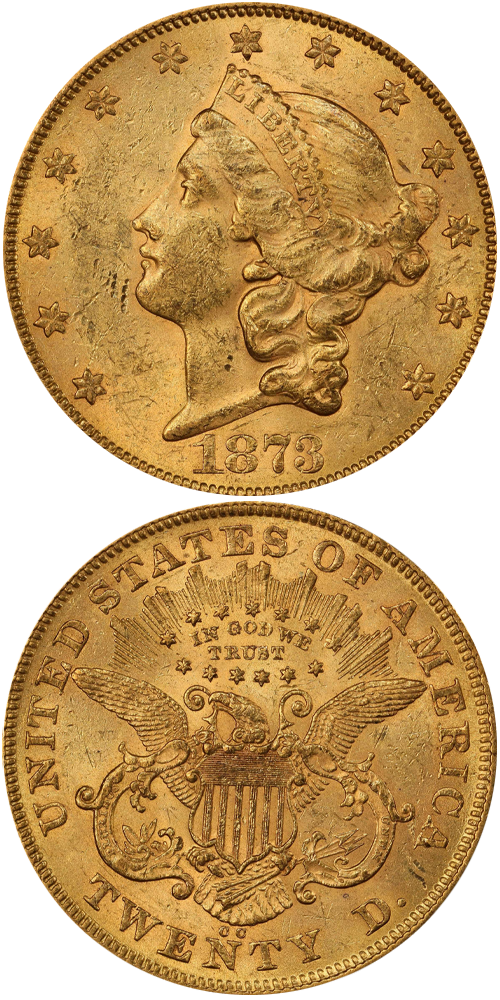1873-CC Liberty Head Double Eagle
Jeff Ambio: This issue was produced using only the Close 3 date logotype, unlike the 1873 and 1873-S double eagles, which are known with both the Close 3 and Open 3 varieties. The date is large, generally even, and the digit 1 is very close to the base of Liberty's portrait. A single reverse die is known, as well, with the CC mintmark small, round and more widely spaced than that seen on 1870-CC, 1871-CC and 1872-CC double eagles. The first C is just left of center over the letter N in TWENTY, and the second C is centered over the right edge of the same letter.
The 1873-CC vies with the 1875-CC as the best produced Carson City Mint double eagle of the challenging Type II design.
Rusty Goe: The annual yield of bullion from Nevada's Comstock Lode had more than doubled in 1873 from what the mining companies had produced in 1870. Despite the manifest quantum leap in local mineral production, the Carson Mint's execution of coinage and bars in January 1873 failed to meet expectations.
The amount of gold the miners, located less than 15 miles away, chose to deposit at their state's mint in 1873 didn't seem to influence the quantity of coins made in that metal. Mintages of all three denominations saw significant to modest declines from the previous year's emissions especially in the double eagles and half eagles. This did not happen at the Philadelphia and San Francisco mints that year (except for eagles), where double eagle production really spiked, especially in Philadelphia.
Coiner Chauncey N. Noteware at the Carson branch took what he had and made the best of it. Fresh with a large deposit of gold in early February, Noteware gave a public demonstration, on the fourth, of how he made the double eagle coins. The Carson Daily Appeal of February 4, 1873, presented an announcement that had become popular in the area. "Those who have never witnessed the process of coining," it said, "may visit the Mint this afternoon with instruction and pleasure." Although capable of stamping out 4,800 double eagles an hour on the big coin press, it is doubtful if Noteware punched more than 1,000 on that chilly Tuesday afternoon in February. By the time he was replaced at the end of June he had delivered only 5,300 double eagles.
Noteware's successor, William "Hy" Doane, who took over the coining department in July, would complete the mintage of double eagles for 1873, adding the final 5,000 coins on the last day of December. Perhaps the residents of Carson City took pleasure, or maybe saw it as a portent of things to come, that the single day's total on December 31 had nearly equaled the total output of double eagles in the first half of the year. The low mintage of 22,410 of the large gold coins in 1873, would pale in comparison to the quantities of that denomination the local manufactory would emit over the next four years.
Q. David Bowers: Of the 1873-CC double eagle mintage, I estimate that 250 to 350 exist today in circulated grades and just five to eight in true Mint State. As noted above, Mint State coins cluster at the low end of this category.
VF and EF grades are about par in auction offerings, although AU coins come on the market every now and then. The year 1873 represents the earliest date for which Carson City double eagles could be reasonably expected to be found in EF grade on a regular basis and occasionally AU.
Auction offerings were few and far between in the early 20th century as no more than a handful of numismatists collected double eagles by mintmarks -- Waldo Newcomer and the younger John Clapp among them. Such coins were available for face value from bank holdings prior to March 1933.
The example to the left was sold by Stack's Bowers Galleries in the Fairmont Collection, JBR Set, where it realized $93,000.






